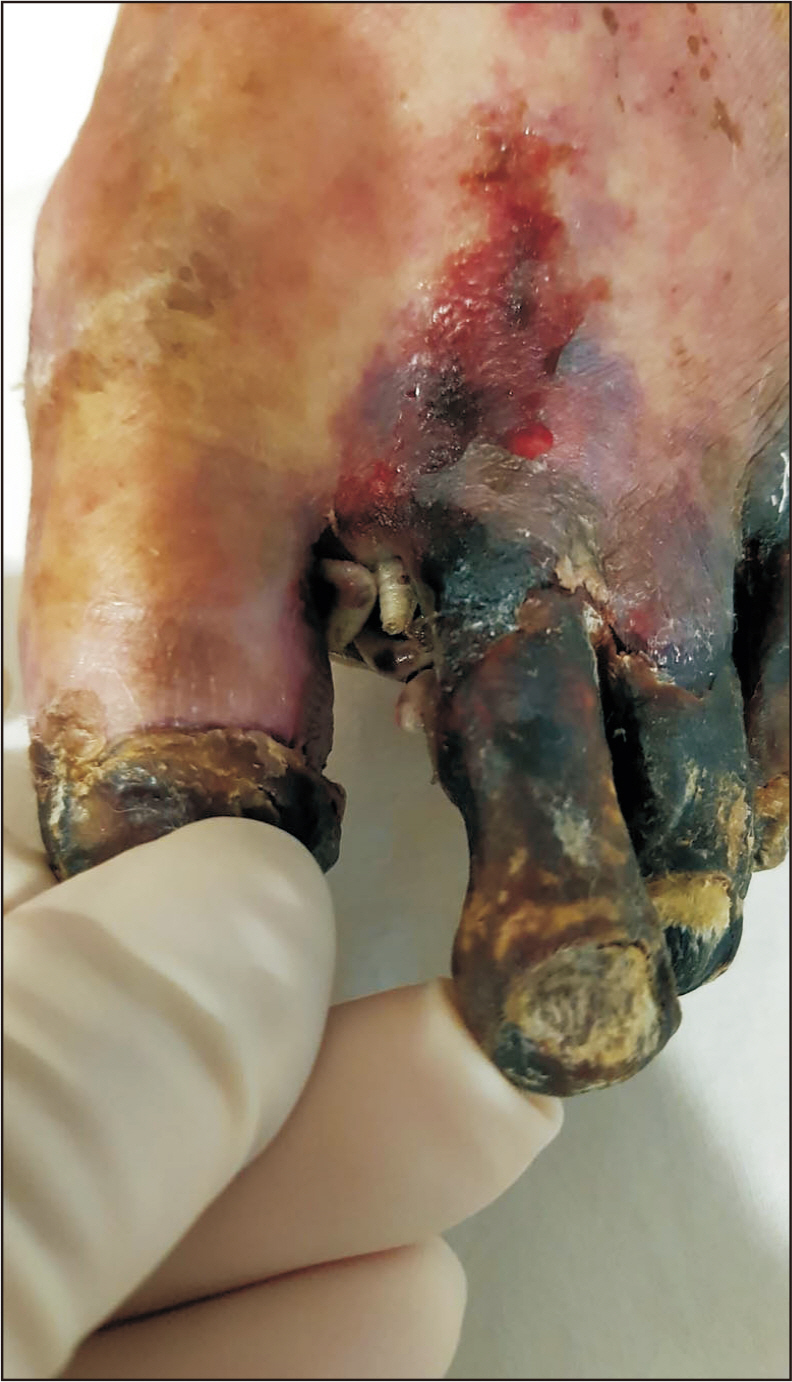J Korean Foot Ankle Soc.
2022 Sep;26(3):148-150. 10.14193/jkfas.2022.26.3.148.
Myiasis with Larvae of Sarcophaga Species in a Diabetic Foot with Gangrene in Korea: A Case Report
- Affiliations
-
- 1Departments of Orthopedic Surgery, Yonsei University College of Medicine, Seoul, Korea
- 2Environmental Medical Biology, Yonsei University College of Medicine, Seoul, Korea
- KMID: 2533198
- DOI: http://doi.org/10.14193/jkfas.2022.26.3.148
Abstract
- Myiasis is the parasitic infestation of the body of a live animal by fly larvae that grow inside the host while feeding on its tissue. Necrotic tissue is a favorable environment for larvae to thrive, which can be seen easily in patients with a diabetic foot. Myiasis in a diabetic foot is rare but is constantly being reported. The common larvae genera causing myiasis are Calliphoridae, Sarcophagidae, and Muscidae. This paper reports a rare case of sarcophaga myiasis in a diabetic foot. To the best of the author’s knowledge, this is the first case report in Korea regarding human myiasis with the sarcophaga genus.
Keyword
Figure
Reference
-
References
1. Singh A, Singh Z. 2015; Incidence of myiasis among humans-a review. Parasitol Res. 114:3183–99. doi: 10.1007/s00436-015-4620-y. DOI: 10.1007/s00436-015-4620-y. PMID: 26220558.
Article2. Francesconi F, Lupi O. 2012; Myiasis. Clin Microbiol Rev. 25:79–105. doi: 10.1128/CMR.00010-11. DOI: 10.1128/CMR.00010-11. PMID: 22232372. PMCID: PMC3255963.
Article3. Callaghan BC, Cheng HT, Stables CL, Smith AL, Feldman EL. 2012; Diabetic neuropathy: clinical manifestations and current treatments. Lancet Neurol. 11:521–34. doi: 10.1016/S1474-4422(12)70065-0. DOI: 10.1016/S1474-4422(12)70065-0.
Article4. Armstrong DG, Boulton AJM, Bus SA. 2017; Diabetic foot ulcers and their recurrence. N Engl J Med. 376:2367–75. doi: 10.1056/NEJMra1615439. DOI: 10.1056/NEJMra1615439. PMID: 28614678.
Article5. Rivers DB, Dahlem GA. The science of forensic entomology. 2014. p. 121–87. Wiley-Blackwell;Hoboken:6. Safdar N, Young DK, Andes D. 2003; Autochthonous furuncular myiasis in the United States: case report and literature review. Clin Infect Dis. 36:e73–80. doi: 10.1086/368183. DOI: 10.1086/368183. PMID: 12652404.
Article7. Uysal S, Ozturk AM, Tasbakan M, Simsir IY, Unver A, Turgay N, et al. 2018; Human myiasis in patients with diabetic foot: 18 cases. Ann Saudi Med. 38:208–13. doi: 10.5144/0256-4947.2018.208. DOI: 10.5144/0256-4947.2018.208. PMID: 29848939. PMCID: PMC6074300.
Article8. Demirel Kaya F, Orkun Ö, Çakmak A, İnkaya AÇ, Ergüven S. 2014; [Cutanous myiasis caused by Sarcophaga spp. larvae in a diabetic patient]. Mikrobiyol Bul. 48:356–61. Turkish. doi: 10.5578/mb.7107. DOI: 10.5578/mb.7107. PMID: 24819275.
Article9. Zaglool DA, Tayeb K, Khodari YA, Farooq MU. 2013; First case report of human myiasis with Sarcophaga species in Makkah city in the wound of a diabetic patient. J Nat Sci Biol Med. 4:225–8. doi: 10.4103/0976-9668.107301. DOI: 10.4103/0976-9668.107301. PMID: 23633868. PMCID: PMC3633283.
Article10. Sherman RA. 2002; Maggot therapy for foot and leg wounds. Int J Low Extrem Wounds. 1:135–42. doi: 10.1177/1534734602001002009. DOI: 10.1177/1534734602001002009. PMID: 15871964.
Article
- Full Text Links
- Actions
-
Cited
- CITED
-
- Close
- Share
- Similar articles
-
- Gastrointestinal Myiasis by Larvae of Sarcophaga sp. and Oestrus sp. in Egypt: Report of Cases, and Endoscopical and Morphological Studies
- Nosocomial Oral Myiasis by Sarcophaga sp. in Turkey
- A Case of Cutaneous Wound Myiasis Associated with Basal Cell Carcinoma by Sarcophaga africa
- Traumatic Myiasis Caused by an Association of Sarcophaga tibialis (Diptera: Sarcophagidae) and Lucilia sericata (Diptera: Calliphoridae) in a Domestic Cat in Italy
- Ignatzschineria larvae Bacteremia Following Lucilia sp. Myiasis in an Irregular Migrant: A Case Report





